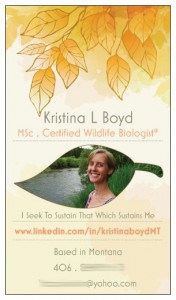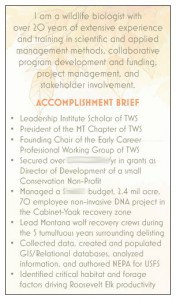No Permanent Job? No Business Card? No Problem!
By Kris Boyd
In honor of the TWS Annual Conference that recently wrapped up in Raleigh, NC, I want to share a networking aid that is becoming more popular and useful for early and mid-career wildlife professionals – myself included. It is called a networking card.
I tried a networking card out at the conference in Raleigh because, to my chagrin, if you had been eavesdropping on the many networking conversations I have had at past conferences, you would have heard something like this:
New Contact: “That sounds great! Do you have a card?”
Me: “Yes… But it only has the main office number so let me write my personal contact information on the back for you… Let me find a pen.”
OR
Me: “Yes… But I’ve changed jobs since then so let me write my new contact information on the back for you… Let me find a pen.”
OR
Me: “No… Do you have a card? I can write my contact information on the back of one of your cards for you… Let me find a pen.”
OR
Me: “No… Do you have a card? No? Let me find a napkin and a pen and I can write my contact information on it for you.”
AND INEVITABLY
New Contact [sighing and producing a pen from their pocket]: “Sure. Here you go.”
As of last month, I resolved never again to be caught in such a distressing situation!
I had known about networking cards for a while, but had never really seen them used or taken the plunge to make my own. The concept is to create a double-sided business card version of your resume. The sky’s the limit on what you want to include and how you want to design it. My only caveat is that it must be easily readable with plenty of open space, brief text, and font sizes no less than 8pt.
The front of the card should give the basics about you and your contact information, which may include the following:
Name
Academic degree(s)/professional credential(s)
Job title and employer (if you think this won’t change soon)
Phone number (and be prepared to receive professional phone calls on it!)
Email address
Physical address
LinkedIn profile/personal website address, or QR codes of these things (labeled with where the code will take you, eg. “LinkedIn”)
Personal tagline (a very short sentence about you)
Portrait photo.
The back of the card should give relevant information about your work/academic qualifications, which may include the following:
One sentence career objective or career summary
Major work/academic accomplishments
Pertinent skills/certifications
Awards/scholarships
Publication summary
And for students or those just starting out you can list:
College you attend(ed)
Major/minor fields of study
GPA
Sounds easy, right?
Wrong!
It can take a lot of pouring over your current resume or CV to pull out what you think will be the most important information to your target audience. Then you have to wordsmith that information so that it is concise and accurate. And then you have to take that information and work it into your chosen card design, which will likely lead to further information parsing and wordsmithing.
It took me about 6 hours to come up with a networking card that I felt reflected my professional qualifications and personality well, and that would remain relevant for at least a year or so. In the process, I passed the design by my 3 year old daughter, who was perceptively right on about the best graphics to use. I passed the text by my adult family, who checked readability, syntax, and spelling errors. And then I passed the final proof by a couple of trusted professional colleagues, who gave the green light for professionalism and relevancy.
I decided to order 100 cards, which was not the best bang for my buck but was a comfortable stockpile size for me. With double-sided color on matte cardstock, the total cost for printing and ground shipping was about $14. Of course, you can bling it up for extra cost, adding options such as special card stock, a glossy front or glossy graphics (leave at least one side matte so it can be easily written on), metallic highlights, raised print, and even unique card shapes.
Ultimately, it is up to you to design a networking card that highlights the unique qualifications and personality that you possess at the price you can afford. So go to it! And if you come to a TWS conference and see me around, I’d love to exchange cards with you.




